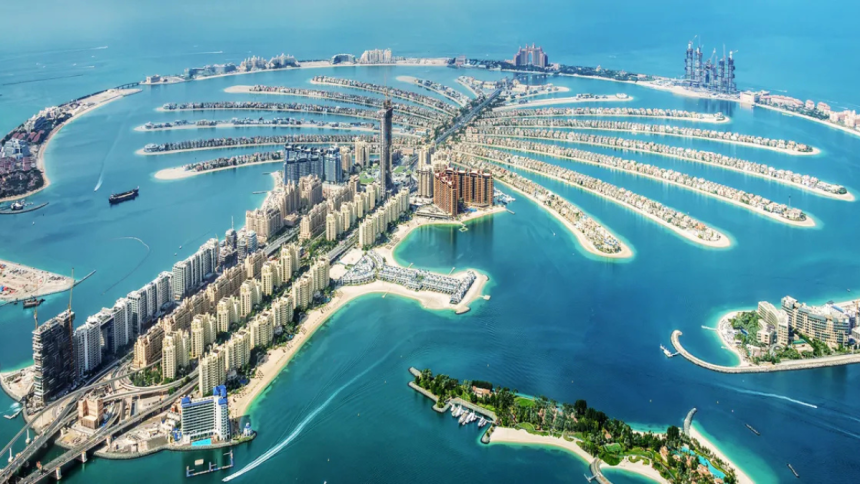With coastal populations steadily increasing and available land in urban centers becoming scarce, cities around the world are rethinking how and where they grow. One bold solution gaining traction is the construction of artificial islands—man-made extensions of the city designed to address land constraints while meeting evolving environmental, social, and economic demands.
In recent years, this concept has shifted from experimental to essential. From Singapore’s Marina Bay to the Netherlands’ Marker Wadden, artificial islands are no longer symbolic feats of engineering—they’re functional urban tools. Nowhere is this more visible than in Dubai, where an ambitious new coastal expansion plan known as Dubai Islands is reshaping how cities engage with their surrounding waters.
Among the first residential developments announced within this growing archipelago is Bay Grove Dubai Islands, part of a master-planned effort to integrate homes, public spaces, and waterfront access in a long-term, sustainable format.
Another example is Zephyra Residences, which is positioned as one of several new communities intended to create livable, walkable environments away from Dubai’s dense mainland districts. These early developments represent the front edge of a broader strategy: to make artificial islands not just possible, but practical—and even preferable—for everyday urban life.
Why Build Artificial Islands?
The core idea behind artificial islands is relatively simple: when land runs out, make more of it. But today’s island projects are more than land grabs—they’re opportunities to experiment with new urban models, design standards, and technological frameworks.
Key drivers behind island development include:
- Urban density relief: Coastal cities often face high real estate demand and limited buildable space.
- Climate adaptation: Artificial islands can be designed with elevated foundations and resilient infrastructure to counter sea-level rise and flooding.
- Integrated planning: Clean-slate urbanism allows for smarter zoning, infrastructure, and mobility networks.
- Economic diversification: Tourism, real estate, and port expansion are common economic incentives.
As cities like Dubai, Jakarta, and Hong Kong consider the long-term sustainability of their urban footprints, artificial islands present a scalable option—if they’re built right.
The Engineering Behind the Vision
Creating habitable land from open sea is no small feat. It requires extensive geotechnical surveys, environmental assessments, and marine engineering expertise. Most artificial islands are built through a process known as land reclamation, where sand and rock are dredged or imported to raise a new landmass above sea level.
Once reclaimed, the new land must be compacted and stabilized—a process that can take months or even years before construction can safely begin. Infrastructure like utilities, drainage systems, and transportation links must also be installed, often before the first building is erected.
Dubai has a track record in this area. Palm Jumeirah, completed in the early 2000s, set a precedent for large-scale coastal development. But newer projects, including Dubai Islands, are moving beyond spectacle. They emphasize engineering precision, environmental responsibility, and long-term livability.
Environmental Considerations: Learning from the Past
Early artificial islands often faced criticism for their environmental impact—disrupting marine ecosystems, increasing erosion, and consuming vast quantities of sand and fuel. Modern island projects are more cautious, incorporating lessons learned from earlier efforts.
Some of the key environmental improvements include:
- Eco-buffer zones to reduce wave energy and preserve shoreline habitats
- Sediment management to reduce water turbidity and maintain marine biodiversity
- Use of recycled construction materials to reduce sourcing pressure on natural reserves
- Marine restoration programs to replenish coral reefs, seagrass beds, and coastal mangroves
These measures aim to align urban development with coastal ecology rather than work against it. In the case of Dubai Islands, environmental assessments have been part of the planning process from the outset.
Urban Design Opportunities on Blank Slates
One of the greatest advantages of artificial islands is the opportunity to rethink urban design from the ground up. Unlike traditional cities with legacy infrastructure, reclaimed land offers a blank slate to plan smarter.
Island-based urban planning typically features:
- Mixed-use zoning: Combining residential, commercial, and recreational areas for convenience and walkability.
- District-level sustainability: Centralized energy systems, integrated water management, and smart waste collection.
- Modular infrastructure: Designed for scalability and adaptability over time.
- Future-proof mobility: Streets and paths designed for electric vehicles, cycling, and autonomous transit.
These features support not only efficiency but also resilience—both key concerns for cities facing an uncertain climate future.
Socioeconomic Dynamics: Who Gets to Live on Artificial Islands?
While artificial islands offer immense potential, there are valid concerns about affordability and access. Many past projects around the world have skewed toward luxury real estate, limiting who can benefit from these new urban areas.
Today, planners and policymakers are under growing pressure to ensure that artificial islands don’t become exclusive enclaves. Instead, the focus is shifting to:
- Affordable housing quotas within new developments
- Accessible public spaces including beaches, parks, and cultural venues
- Community services like schools, clinics, and transit hubs
Projects that prioritize inclusivity from the start are more likely to succeed in the long term—socially, economically, and politically.
The Global Outlook: More Cities Turning to the Sea
Dubai is not alone in its island-building ambitions. Across Asia and Europe, cities are increasingly turning to artificial islands as climate-resilient extensions of the urban fabric. Examples include:
- Singapore’s Pulau Brani redevelopment, which integrates coastal protection with housing and commerce
- The Netherlands’ Marker Wadden, a restoration-focused archipelago enhancing biodiversity and tourism
- South Korea’s Songdo International Business District, partly built on reclaimed land, focused on smart city design
These projects differ in purpose and scope but share a common ethos: reimagining what coastal cities can be in the 21st century.
Artificial islands are no longer symbols of excess—they’re becoming instruments of necessity. As cities seek to balance growth with sustainability, developments like Dubai Islands demonstrate how artificial land can support more than just expansion—it can support evolution.
Whether it’s the early stages of community planning at Bay Grove Dubai Islands, or the integration of new neighborhoods such as Zephyra Residences, these projects reflect a broader shift in urban thinking: from reactive building to proactive, resilient design.
As more coastal cities look seaward for solutions, the success—and shortcomings—of artificial islands will shape how urban life unfolds at the water’s edge for decades to come.
Lynn Martelli is an editor at Readability. She received her MFA in Creative Writing from Antioch University and has worked as an editor for over 10 years. Lynn has edited a wide variety of books, including fiction, non-fiction, memoirs, and more. In her free time, Lynn enjoys reading, writing, and spending time with her family and friends.















